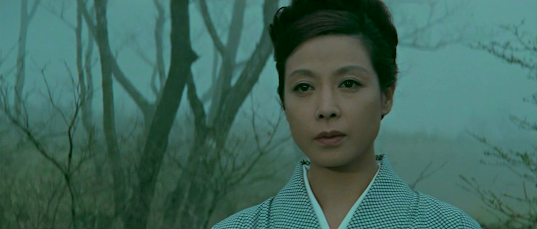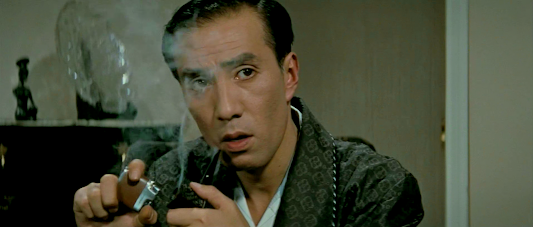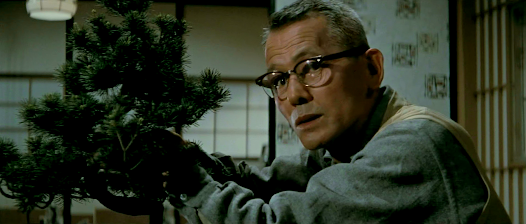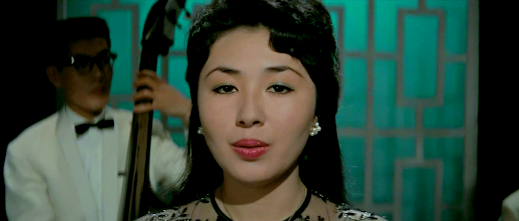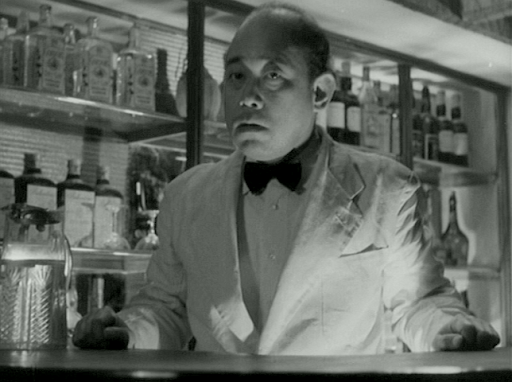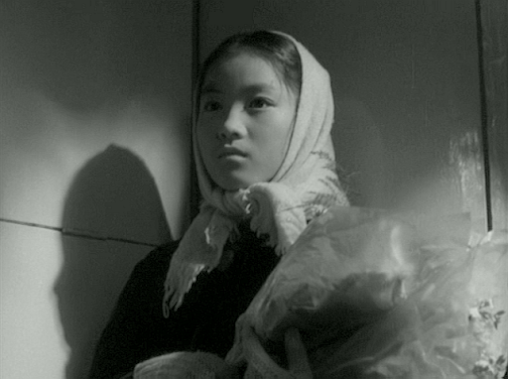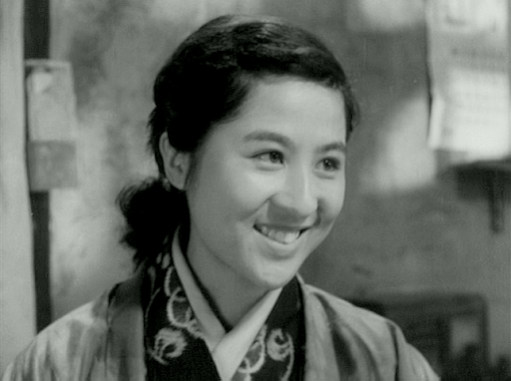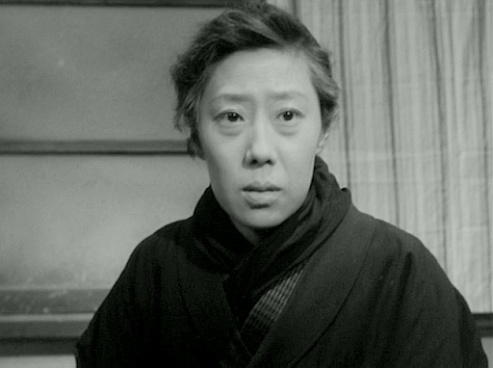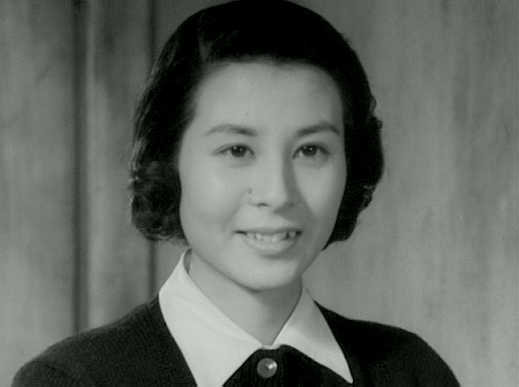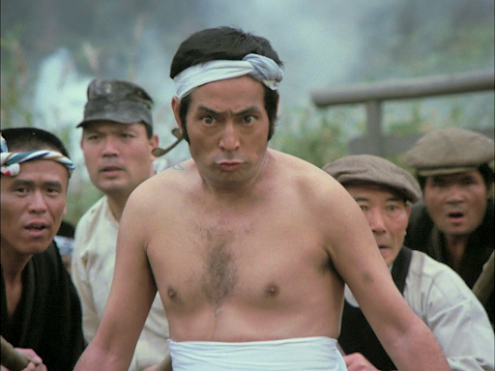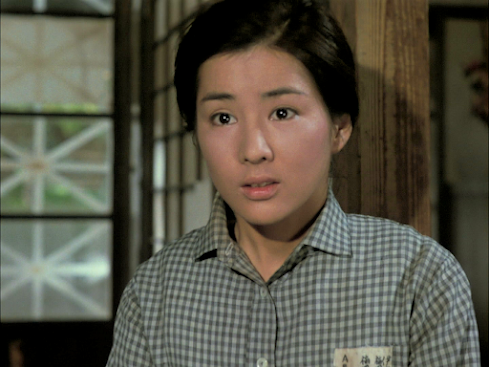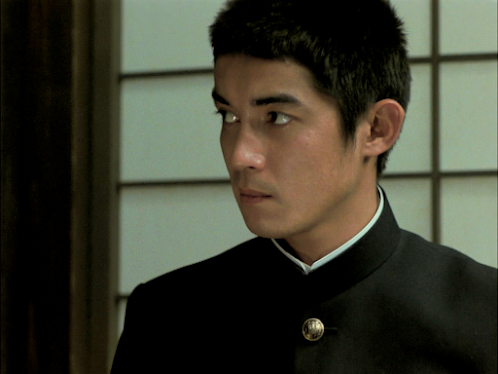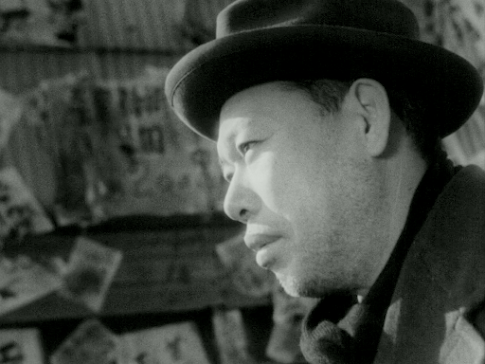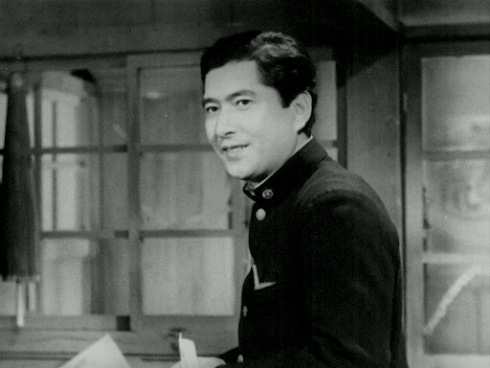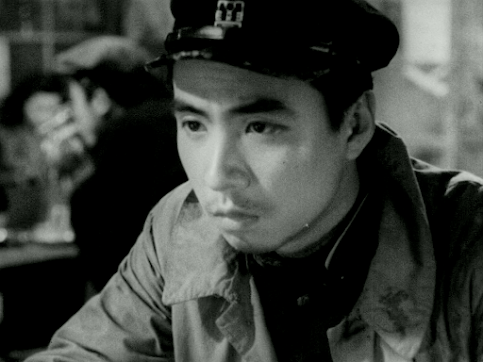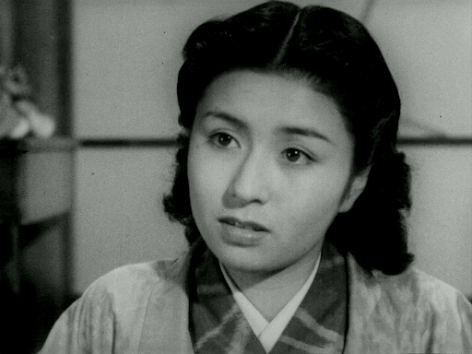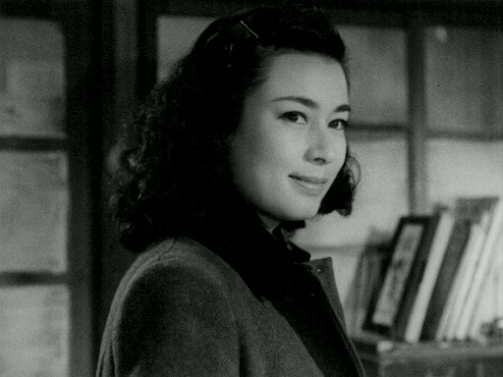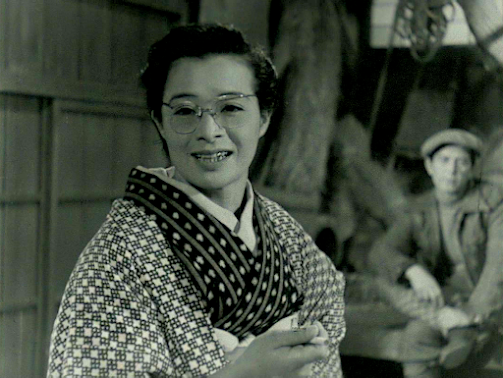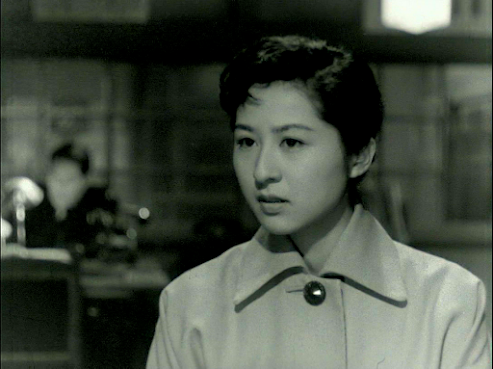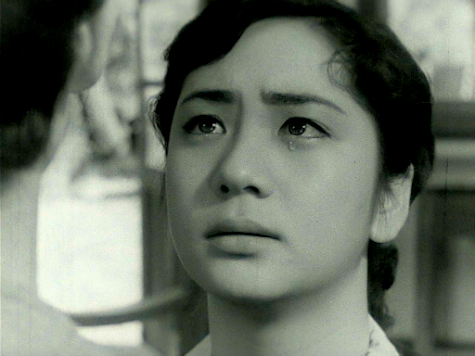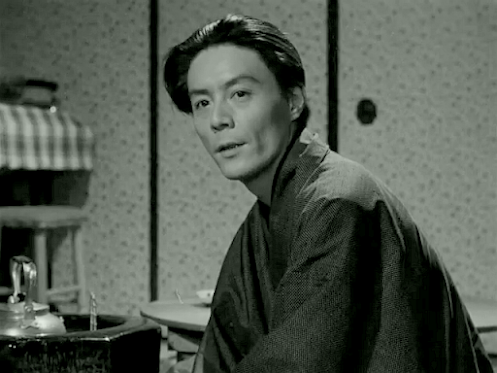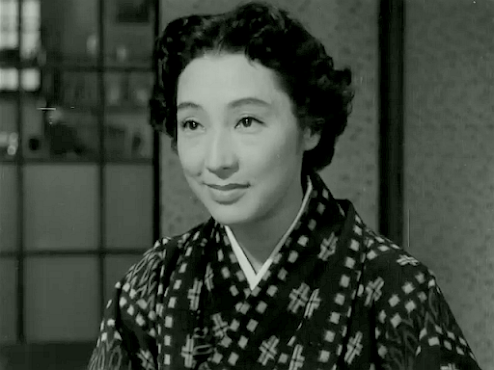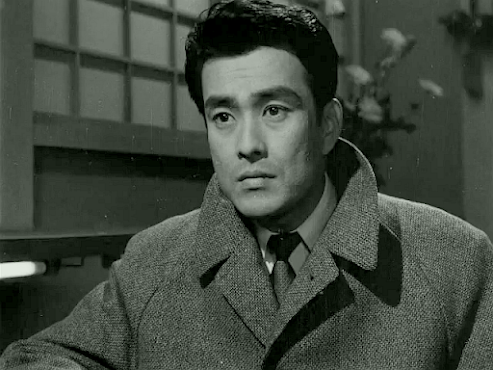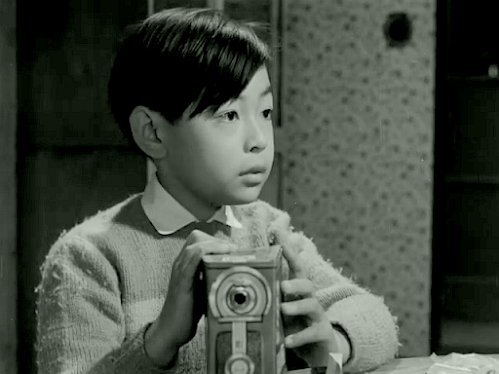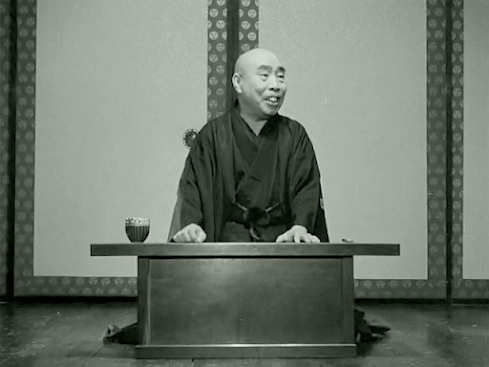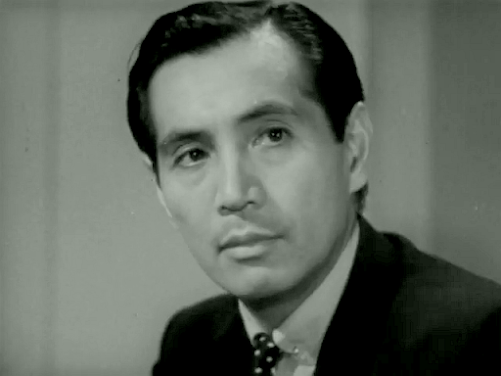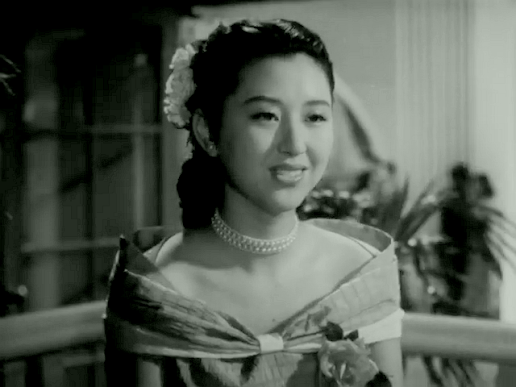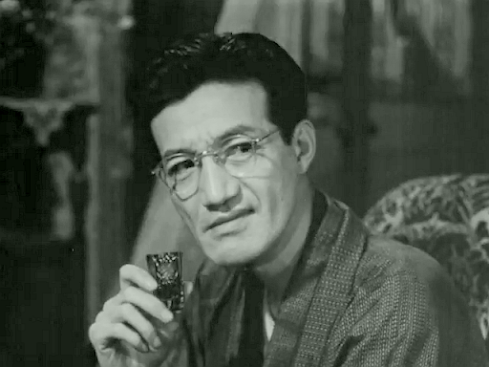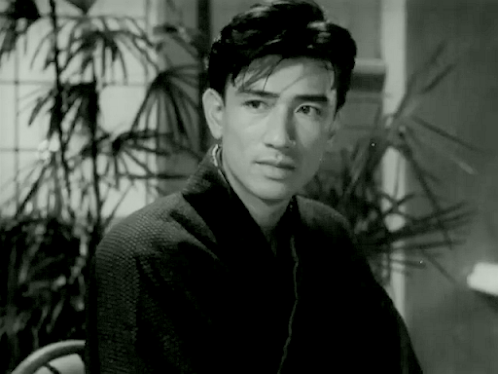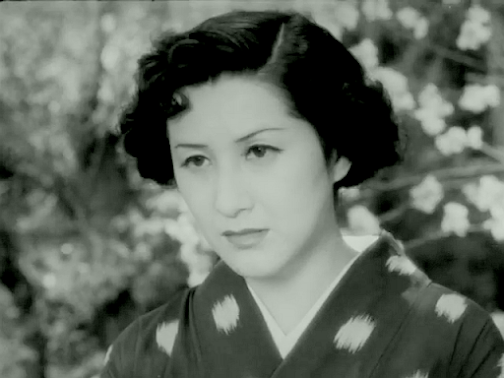M.R. Dowsing's Blog, page 6
February 21, 2025
Oyafuko dori / 親不孝通り (1958)
Obscure Japanese Film #168
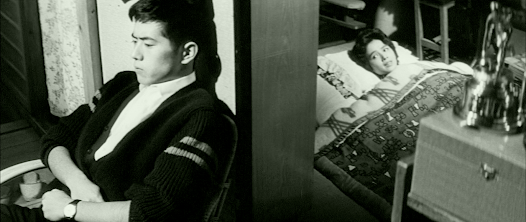 Hiroshi Kawaguchi and Yoko Katsuragi
Hiroshi Kawaguchi and Yoko KatsuragiKatsuya (Hiroshi Kawaguchi) is a cynicalstudent who studies as little as possible, preferring to spend his timegambling, picking up women and getting drunk. He lives with his sister, Akie(Yoko Katsuragi), and is very protective of her, so, when he learns that shehas had an abortion after becoming pregnant by Shuichi (Eiji Funakoshi), whorefuses to marry her, he vows revenge. Katsuya discovers that Shuichi also hasa sister, Kaneko (Hitomi Nozoe), and he decides to do the same to her…
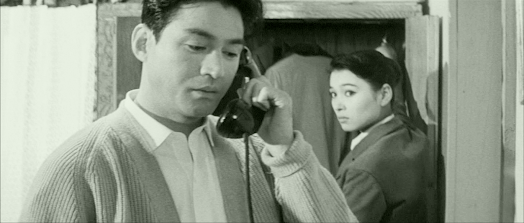 Eiji Funakoshi and Hitomi Nozoe
Eiji Funakoshi and Hitomi Nozoe
This Daiei productiontells a none-too-subtle story in which yet another woman falls in love with herrapist, which seemed to be a popular theme in Daiei films of this era. Unsurprisingly,it was written by a man – in fact, it was based on a story by HiroshiKawaguchi’s dad, Matsutaro Kawaguchi, who also happened to be executivedirector of Daiei.
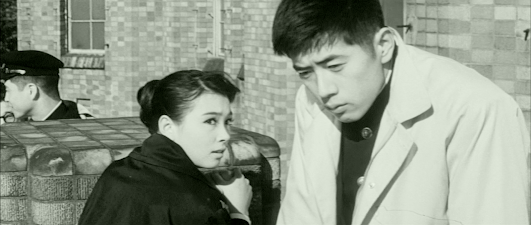
A little HiroshiKawaguchi goes a long way, in my opinion, and – unfortunately – there’s a lot ofhim to endure in this film. He can be good in comic roles on occasion, but hisclumsy one-note performance here does nothing for the already unpromisingmaterial, while his future wife, Hitomi Nozoe, is saddled with a role in whichshe’s required to be naïve beyond belief. However, perhaps Kawaguchi could takecomfort in the knowledge that his was not the worst performance in the film –that honour goes to the uncredited male ‘singer’ featured in a nightclub scenenear the beginning, who appears to be trying to imitate American rock ‘n’ rollsingers, but succeeds only in making a colossal arse of himself.
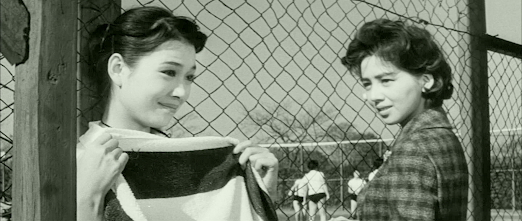
The Japanese titletranslates as something like ‘Lack of Filial Piety Street’, which obviously doesn’twork in English, but is apparently an unofficial name used for certain streetsin many Japanese cities where students congregate and behave badly. The film issometimes listed as Disobedience, butI’m not sure that was ever an official English title and it doesn’t suit themovie very well.
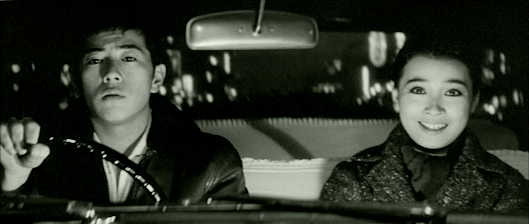
There might have been agood film to be made about a street frequented by students pursuing hedonism whilethey have the chance before having to buckle down to the salaryman life, butthis ain’t it. A film about the absurdity of pursuing the tenet of an eye foran eye could also be a winner, but this ain’t that, either. It’s a film whichwants to have its cake and eat it, and the contradiction inherent in acharacter who loves his sister and wants to protect her but will happily rapeanother woman to get revenge on somebody else is merely shrugged off. Theincredibly flippant ending to the film delivers the coup de grace to one ofdirector Yasuzo Masumura’s most dispensable works.
Thanks to A.K.
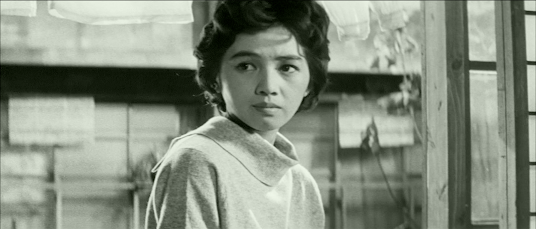
February 15, 2025
Four Sisters / 山麓 / Sanroku (‘The Foot of the Mountain’, 1962)
Obscure Japanese Film #167
 Isuzu Yamada
Isuzu Yamada Yoshiko Mita
Yoshiko MitaModern-day Tokyo. Masako (Yoshiko Mita) is a young woman who wantsto marry mountaineer Shinkichi (Sonny Chiba), but her domineering mother (IsuzuYamada) wants her to wed the more financially solvent Sakurai (Fumio Watanabe).Once Sakurai begins courting her, Masako finds herself warming to him andbecomes torn between the two men, so she begins to consider the marriages ofher three older sisters in order to help her decide what to do.
The eldest, Kikuno (Chikage Awashima), has been trapped in anunhappy and childless marriage to the wealthy Mitsumine (Ko Nishimura) for thepast 10 years. Mitsumine loves her but has constant affairs on the side whichhe thinks Kikuno should just accept. The next sister, Misao (Chikage Ogi), ishappily married to Igarashi (Tetsuro Tanba), with whom she has two children.Third sister Kanako (Kaneko Iwasaki) has angered their mother by eloping withAsayama (Hiroshi Minami), but leads a cheerful life with him in their smallapartment and is newly pregnant.
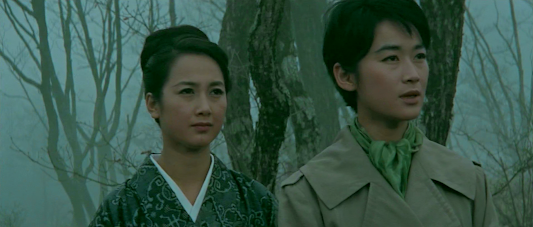 Chikage Ogi and Kaneko Iwasaki
Chikage Ogi and Kaneko Iwasaki
The father of the four sisters (Chishu Ryu) is a classic henpeckedhusband who failed in business and now keeps his head down, busying himselfwith his bonsai while letting his wife make all the decisions. However, afamily crisis is provoked when Kikuno – who had married Mitsumine at hermother’s urging – decides she’s had enough and leaves him, which will cut offan important source of income for the family…
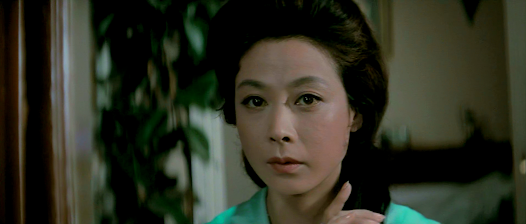
As the IMDb page for this film not only contains a poster and afew stills in black and white, but also states that the film was shot that way,I was surprised to find that it’s actually in colour and, in fact, rathernicely shot by cinematographer Masahiko Iimura. A Toei production, it’s basedon a just-published novel by Fumio Niwa, who also wrote the novels on which The Beloved Image (1960) and Women of Tokyo (1939) were based. Theadaptation is by Zenzo Matsuyama, who had recently become a director himself,but this one is helmed by Masaharu Segawa (1925-2016), a director best-knownfor comedies, which this certainly ain’t. It’s the only film I’ve seen bySegawa, but it’s made with a sure hand and features consistently cleverblocking of scenes and good performances across the board. The tasteful musicby Ichiro Saito is also a plus.
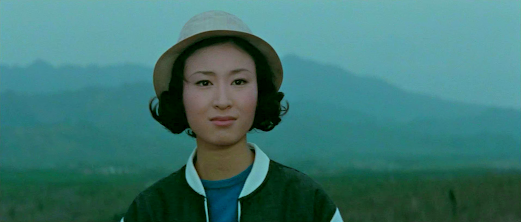
The mountain serves as a metaphor for marriage here, which is seenas a difficult journey that many abandon before reaching the peak, so theyoungest sister is at ‘the foot of the mountain’ which was also the title ofthe novel and film in Japanese. The climax of the film involves a literalmountain, and this part does get a little melodramatic and corny, it has to besaid, but not fatally so.
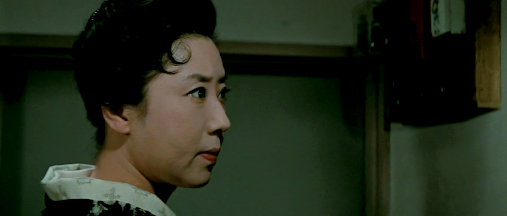
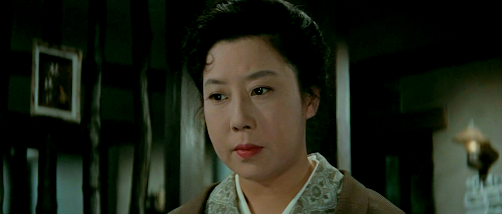
Among a strong cast, the chameleon-like Isuzu Yamada delivers the finestperformance as the apparently cold and materialistic queen bitch matriarch who,deep down, is actually insecure about both her position and her fading looks. Surprisingly,she was not even nominated for an award for this, but perhaps it’s simplybecause she’d already won a handful.
The film also features a cameo by popular singer Kazuko Matsuo, whoappears crooning the film’s theme song in a nightclub.
February 12, 2025
Ai sureba koso / 愛すればこそ / (‘Only If You Love’, 1955)
Obscure Japanese Film #166
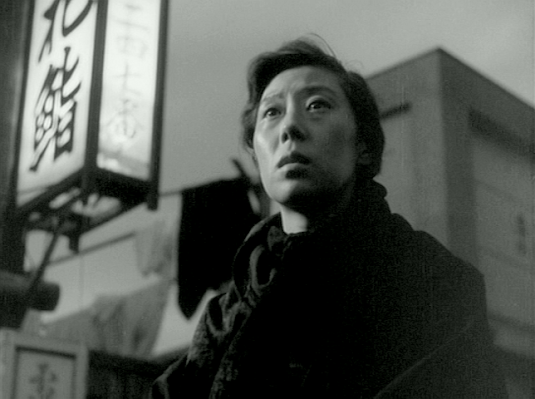 Isuzu Yamada
Isuzu YamadaThisomnibus film comprised of three stories was an independent venture co-producedby two companies. One, Kindai Eiga Kyokai, was formed bydirector Kozaburo Yoshimura, screenwriter Kaneto Shindo and actor TaijiTonoyama in 1950. The first episode is directed by Yoshimura, written by Shindoand features Tonoyama in a minor role as a bartender.
The other company involved, ChuoEiga, was established in 1952 by Akihiro Hoshino, who wanted to encouragecultural exchange between Japan and the Soviet Union and was responsible fordistributing The Battleship Potemkin (1925)for the first time in Japan in 1955. Given these facts, it should be nosurprise that episodes 2 and 3 are directed by Tadashi Imai and Satsuo Yamamotorespectively – both Communist Party members.
Shotin 10 days with cast and crew apparently all working for free, it’s a well-madefilm which packs so much into its scant 83-minutes that it’s not reallypossible to get bored. The individual stories are as follows:
Flower Girl
Michie (Nobuko Otowa) isa Ginza bar waitress who takes pity on Tamiko (Yoshiko Machida), a young girlout selling flowers in the rain one night. When tragedy strikes them both insimilar ways, the two end up forming an unlikely friendship…
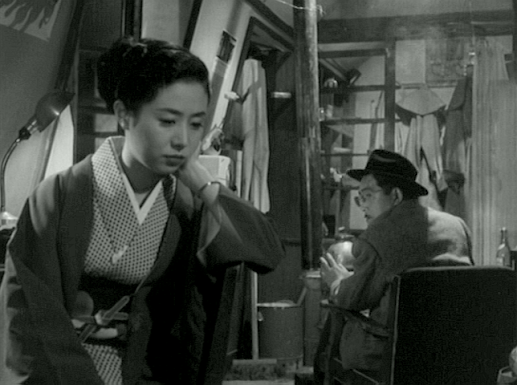 Nobuko Otowa and Takashi Kanda
Nobuko Otowa and Takashi Kanda
The Bride Who Jumped In
Factory worker Kono(Taketoshi Naito) is surprised to be woken up by his landlady (Toyo Takahashi) onemorning and informed that he has a visitor who turns out to be Kuniko (KyokoKagawa), a young woman whom his family have arranged to be his wife without hisknowledge…
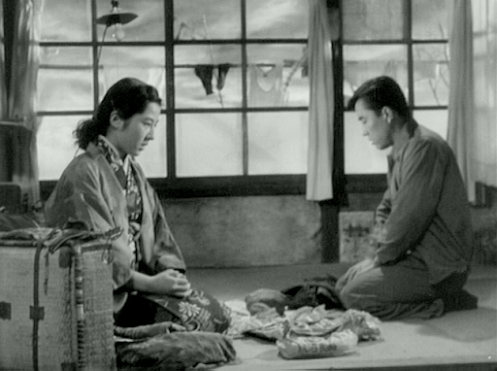 Kyoko Kagawa and Taketoshi Naito
Kyoko Kagawa and Taketoshi Naito
OnlyIf You Love
Yaeko (Isuzu Yamada) isan ageing widow who works as a cleaner at the racetrack and has developed astoop from her years of menial labour. Her son, Shigeru (Kei Taguchi), is inprison for clashing with police during a student protest, so Yaeko is left onher own to deal with an unhappy 27-year-old daughter, Toshiko (Hatae Kishi),whose marriage is on hold until Shigeru gets out, and her equally unhappy youngersister, Minako (Sanae Nakahara). One day, their uncle, Goro (So Yamamura),turns up and says that all Shigeru has to do to get released is expressrepentance for his actions…
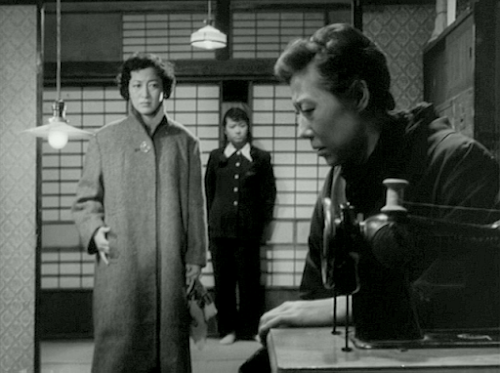 Hatae Kishi, Sanae Nakahara and Isuzu Yamada
Hatae Kishi, Sanae Nakahara and Isuzu Yamada
The first two storiesare heart-warming enough, though slight, while Yamamoto and his screenwriter (andfellow communist) Yusaku Yamagata – who also wrote episode 2 – attempt somethingmore ambitious in part 3. Unfortunately, it’s shameless propaganda in which themessage is that it’s preferable to ruin the lives of those close to you than itis to be thought of as having betrayed your principles. Still, at least we getan excellent lead performance from Isuzu Yamada – I can’t think of anotherJapanese actress who went from being a leading lady to becoming such aversatile character actor – and a last-minute cameo from Yoshiko Kuga asPerfect Communist Girlfriend. The film was released in the Soviet Union in1957.
Thanks to A.K.
DVD at Amazon Japan (no English subtitles)
February 9, 2025
The Gate of Youth / 青春の門 / Seishun no mon (1975)
Obscure Japanese Film #165
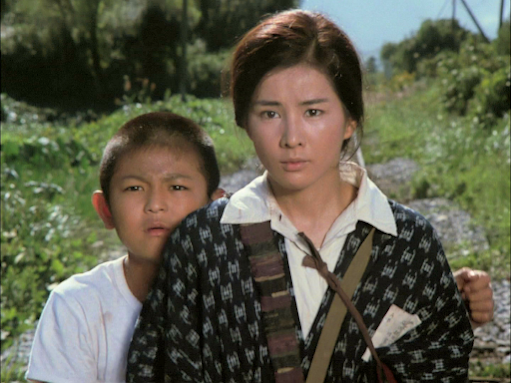 Tomohiro Tanabe and Sayuri Yoshinaga
Tomohiro Tanabe and Sayuri YoshinagaBased on the first part of a bestselling doorstop novel byHiroyuki Itsuki (b.1932) and running over threehours, this big-budget Toho production spans a period of over 30 years from1918 to the 1950s, and tells the story of Shinsuke, the son of a Fukuoka coalminer,as he is raised alone by his stepmother (after his father is killed attemptingto rescue some trapped Korean miners), survives the Second World War, growsinto a man and has his first sexual and romantic experiences.
The first half hourfocuses on Shinsuke’s father, Juzo, a tough, brawling miner with a sense ofjustice, who not only tries to save the exploited Koreans, but had earlierfought against the army as they tried to suppress the workers’ rebellion duringthe rice riots of 1918. Played in full scenery-chewing mode by Tatsuya Nakadai,he is known as the ‘climbing spider’ and sports a large spider tattoo on hisback à la Ayako Wakao in Irezumi(1966). He completely dominates the opening scenes, then departs with a fartgag and is only briefly glimpsed again in a couple of flashbacks.
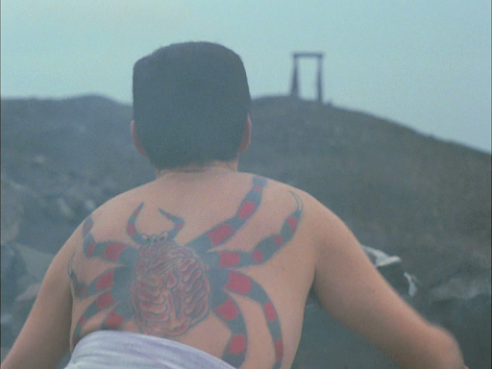
Once Juzo dies,Shinsuke and his stepmother become the focus. As the character grows from avery young child into a man during the course of the movie, Shinsuke is playedby a number of actors, but mainly by Tomohiro Tanabe as a pre-teen and teenager,and by Ken Tanaka as an adult. His stepmother, Tae, is portrayed by SayuriYoshinaga, a big star in Japan who has remained little-known abroad butdelivers the film’s most convincing performance.
The beginning of themovie, with its use of speeded-up film and voiceover from a narrator (ShoichiOzawa) who sometimes even pops up on screen (once during a sex scene, of whichthere are some weird ones) made me wonder if I was in for some irreverent, KihachiOkamoto-inspired wackiness, but these eccentric touches ultimately proved toointermittent to seem anything other than occasional bits of whimsy on the partof the director, Kirio Urayama. A former assistant to Shohei Imamura, Urayamahad won the Blue Ribbon Award for Best New Director for his debut film, Foundry Town (1962), also starring SayuriYoshinaga. Subsequently, he appeared to struggle to find enough work and onlymanaged to complete 10 films before his death at 54 in 1985. Perhaps personalhygiene may have been a reason for his lack of employment, as his JapaneseWikipedia page states:
He hated baths, and when he wentto Seijun Suzuki's house while drunk, he was locked naked in the bathroom bySeijun and his common-law wife (whom he later married) because of the terriblesmell. However, he managed to escape naked through the bathroom window.
The film proved to be ahuge hit at the Japanese box office, leading not only to a sequel two yearslater, but to a remake (with its own sequel) a mere six years after theoriginal as well as a number of TV adaptations.
Shot in academy ratio,the film looks pretty good, making effective use of real locations and suggestingclose attention to historical details in the dressing of the sets, etc.However, I found the character of Shinsuke unsympathetic and many of theperformances too broad, while I felt that the writing never rose above thestandard of melodrama, the music was uninspired and the whole thing too vulgarand sentimental. In fairness, though, I should point out that a lot of peopleseem to like this movie and other opinions are available…
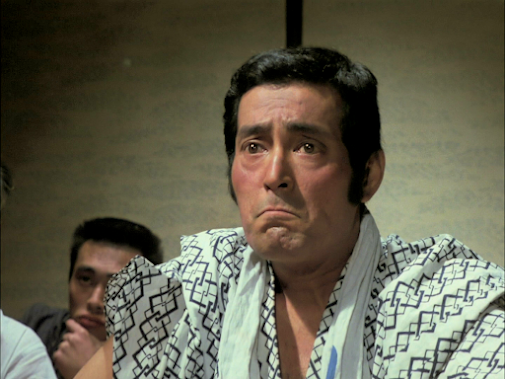
Watchedwith dodgy subtitles.
Thanksto A.K.
February 5, 2025
Shunsetsu / 春雪 / (‘Spring Snow’, 1950)
Obscure Japanese Film #164
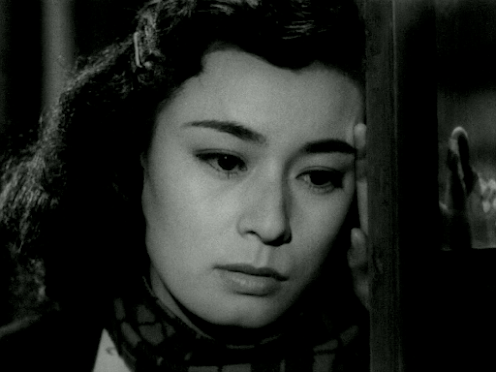 Yasuko Fujita
Yasuko FujitaTakako (Yasuko Fujita)is a young woman who works on the ticket desk at her local train station inDenenchofu on the outskirts of Tokyo. The eldest child of a father (TakashiShimura) who has been made redundant - though he doesn’t tell his family for amonth - she hopes to wed train driver Toshio (Shuji Sano), but they cannot yetafford to marry. Not only are the family are struggling to get by, but Takako’smother (Yuriko Hanabusa) is unwell and her younger brother (Teiji Takahashi) hasstarted hanging out with a bad crowd. But when Takako’s younger sister Tomoko(Akiko Sawamura) finds work as a maid to a wealthy orchestra conductor (IchiroRyuzaki) who takes a shine to Takako, it looks like the family’s problems couldbe solved if she would only forget Toshio and marry him instead…
This Shochikuproduction is unrelated to the later Yukio Mishima novel which shares itsEnglish title and was written as an original screenplay by Kaneto Shindo, oneof around 40 he wrote for the director of this film, Kozaburo Yoshimura. Idon’t remember the war itself being mentioned, but the poverty of the post-waryears is emphasized throughout, and the family even try to grow vegetables intheir garden to save a few yen. They tend to put up a cheerful front when together, but often fallinto depression on their own. We see Takiko riding a train and staring at thetracks as it speeds along as if seeing her life laid out before her in astraight line leading to nowhere, while her father eats his packed lunch in theruins of the steelworks where he used to be employed and which was, presumably,demolished due to the war ending. Typically for Japanese drama, the storyrevolves around a classic giri(obligation) versus ninjo(inclination) conflict – in this case, if Takako marries the rich guy, herfamily will be saved. As it was made during the American occupation, however,the film also promotes western culture and values, and on one occasion we seeTakako attending a ballet, while on another she and Toshio are seen sittingoutside a Christian church where a wedding is taking place and admiring thesound of the choir singing a hymn within.
The star of this film,Yasuko Fujita, was a theatre actress who had been hand-picked by Yoshimura toplay the lead role despite never having appeared in a film before. It’s animpressive debut, and she not only looks the part, but acts it in such a waythat she seems like a natural for the movies, betraying not even a hint oftheatricality in her performance. Unfortunately for the Japanese cinema, shemarried a well-known music promoter in 1953 and retired from acting having madea dozen films, the most widely-seen of which is probably Yoshimura’s Clothes of Deception (1951), in whichshe co-starred opposite Machiko Kyo. Her Japanese Wikipedia page contains theenigmatic comment that ‘She reportedly made the most of her good looks wheninteracting with foreign celebrities.’ Yasuko Fujita passed away in 2015 aged88.
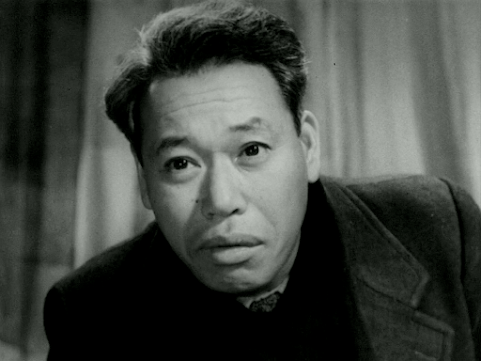
Among the rest of thecast, the most notable is Takashi Shimura, and it’s nice to see that he’s nottotally wasted here as he was so often when not working with Kurosawa. In Spring Snow, he gets to play a characterwith more than one dimension who goes through his own struggle against bothhimself and his circumstances.
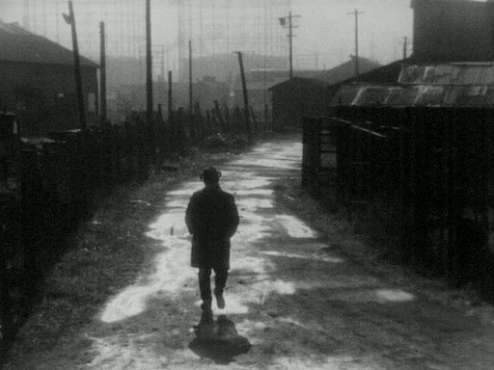
Although I wouldn’t goas far as to claim it as any kind of forgotten masterpiece, Spring Snow has quite a lot going forit, including the cinematography of Toshio Ubukata (who also worked forKurosawa) and the mostly well-developed characters, who feel worth spendingtime with.
Thanks to A.K.
February 2, 2025
Why Did These Women Become Like This? / 何故彼女等はそうなったか / Naze kanojora wa so natta ka (aka Girls’ Reform School, 1956)
Obscure Japanese Film #163
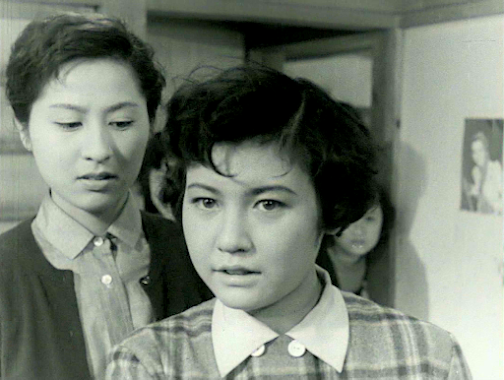 Kyoko Kagawa and Masako Nakamura
Kyoko Kagawa and Masako NakamuraThis social consciencepicture from Shintoho studios stars Kyoko Kagawa as Miss Oda, a kindly teacherat a reform school for wayward teenage girls that stands in the shadow of acastle. Among the girls are Hiroko (MasakoNakamura), a new arrival who comes from a wealthy family but has begun behavingbadly after discovering that she was an illegitimate child; Yoneko (Akiko Mie),who is secretly pregnant; Tomiko (Konomi Fuji), whose good behaviour at theschool sees her sent back home only to receive a cold reception from her stepmother(Wakako Kunimoto), causing her to run away again and end up back at thereformatory; and Chiyo (Junko Ikeuchi), who is in danger of being sold intoprostitution to a brothel-keeper (Chieko Naniwa, who I’m sure has played thistype of role in a number of films).
Somewhatsurprisingly, the film was based on a 1952 novel by a male author, ToshihikoTakeda 1891-1961). However, he had some experience in these matters, having co-foundedthe Association for the Improvement of Children in 1947 and established anactual ‘Girls’ Home’ in 1949 in Muragame on the northern tip of Shikokuisland. (Incidentally, Muragame does have a castle, although I’m uncertain ifit’s the one we see in the film.)
The supposed badbehaviour of the girls seems pretty mild today – this is not exactly a female Scum – but, then, writer-directorHiroshi Shimizu clearly wants us to view them with unreserved sympathy. Thereal bad behaviour is on the part of the uncaring parents, etc, who made themthis way, and the unforgiving, self-righteous communities who deny them asecond chance. The Japanese aphorism derikugi wa utareru (‘the nail that sticks out gets hammered down’) springs tomind here.
The film certainly gets its message cross, but feels like fairlyminor Shimizu. The religious-sounding choral music which sounds as if it hascome from a corny Hollywood Christmas movie has not dated well, and the filmmisses a trick in failing to provide Miss Oda with any backstory, though KyokoKagawa gives her usual fine performance in a role similar to that which sheplayed in the later picture The HumanWall (1959). The acting is pretty good across the board, in fact, though ofthe young actresses who play the girls only Junko Ikeuchi went on to stardomand sustained a long career.
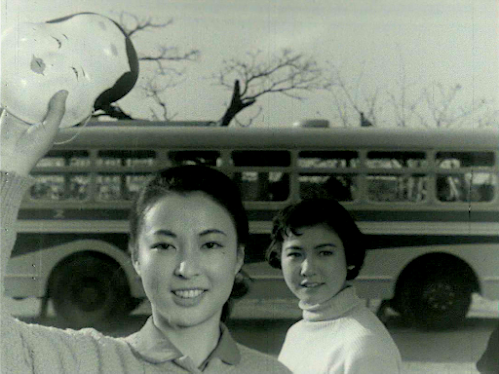 Junko Ikeuchi and Masako Nakamura
Junko Ikeuchi and Masako Nakamura
Thanks to A.K.
January 27, 2025
Kodomo no me / 子供の眼 / (‘Eyes of a Child’, 1955)
Obscure Japanese Film #162
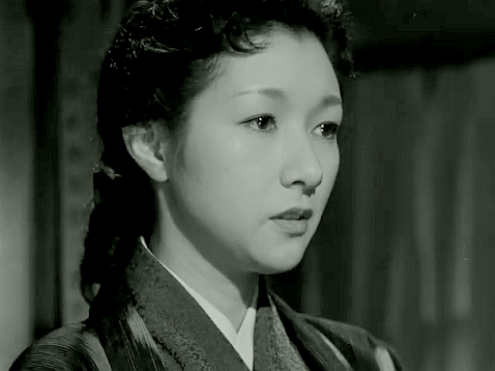 Hideko Takamine
Hideko TakamineKiyoko (Hideko Takamine) is a young woman living in Tokyo with herolder brother, Shunji (Hiroshi Akutagawa), and his second wife, Sachiko (MiekoTakamine – no relation to Hideko), a dentist. They have a 10-year-old son,Osamu (Koji Shitara), by Shunji’s deceased first wife, and it’s left to Kiyoko totake care of him.
However, when Sachiko’s ageing father (Chishu Ryu) begins tohave health issues, Shunji gets offered a promotion which involves moving toNagoya, and Kiyoko receives a promising marriage proposal from factory worker Fujita(Minoru Oki), it becomes clear that this arrangement cannot last indefinitelyand tensions arise…
This Shochiku production was directed by YoshiroKawazu, a former assistant to Keisuke Kinoshita who also often co-wrotescreenplays with the writer of this film, Zenzo Matsuyama (who married Hideko Takamine the year this wasmade). Kawazu directed 24 films between 1955 and 1969, then went into TV whenfilm work dried up before passing away at the early age of 46 in 1972 (I don’tknow the cause). He won the 1956 Blue Ribbon Award for Best Newcomer for thisfilm and Namida (‘Tears’), while thefilm itself shared the 1955 Golden Globe Award for Best Foreign Language Filmwith Dreyer’s Ordet (Denmark), Michael Cacoyannis’ Stella (Greece), Laslo Benedek’s Sons, Mothers and a General (West Germany) and a Mexican filmcalled Curvas Peligrosas (‘DangerousCurves’) which has fallen into a profound obscurity. For some reason, thisparticular award was usually shared among entries from several countries at thetime, but it’s still surprising that a modest little movie like Eyes of a Child would be submitted, letalone win.
Kawazu’s film (his second) was based on a then newly-published novelof the same name by Ineko Sata (1904-98; incorrectly listed on IMDb as ‘InekoSada’), a feminist and former member of the Communist Party who was eventuallyexpelled for criticising the party. The presence of Chishu Ryu and child actorKoji Shitara recalls the films of Ozu, and this domestic drama is in a similarvein, though it mostly lacks the contemplative, bittersweet quality of Ozu’swork. There’s so little drama in the first half that it all seems ratherinconsequential, but it does become more interesting once an element ofconflict is introduced later in the film. Although the title suggests that thestory is told through the eyes of a child, this is not the case, but there ismore attention paid to his feelings than in most other films of its type. KeisukeKinoshita’s brother Chuji provides a surprisingly low-key music score (usedsparingly), there’s a cameo by famous rakugostoryteller Sanyutei Kinba III (1894-1964) and a gloriously weird modern balletperformance by the ‘Youth Ballet Group’.

And, of course, there’s Hideko Takamine – not in one of her mostinteresting roles, perhaps, but still demonstrating the naturalness andsubtlety of expression that made her one of the cinema’s finest actors.
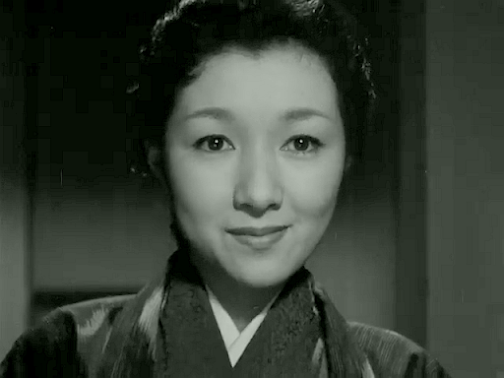
January 18, 2025
Junpaku no yoru / 純白の夜/ (‘Pure White Nights’, 1951)
Obscure Japanese Film #161
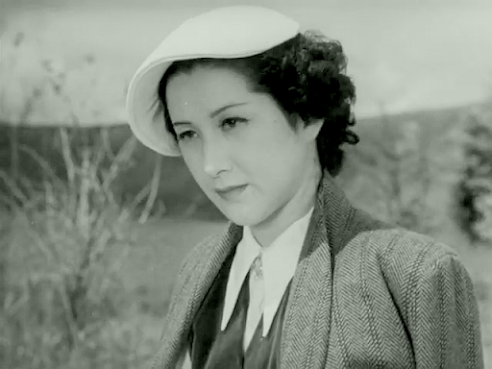 Michiyo Kogure
Michiyo KogureIkuko (Michiyo Kogure) is a young woman happily married toTsunehiko (Seizaburo Kawazu), a banker. At a party, she dances with one of hisfriends, Kusunoki (Masayuki Mori), a dapper businessman. Afterwards, she’s surprisedto discover that Kusunoki has slipped a note into her bag confessing his lovefor her. Ikuko informs her husband, who finds the situation amusing and advisesher to ignore it and carry on as if nothing has happened. However, Kusunokiproves to be persistent and Ikuko begins to develop feelings for him in spiteof herself.
Meanwhile, Ikuko’s younger sister, Tsuyuko (Keiko Tsushima), wantsto marry a penniless actor-playwright (Keiji Sada), but her mother (SachikoMurase) won’t allow it and wants her to marry Tsunehiko’s colleague, Sawada(Kinzo Shin). Ikuko regards Sawada with contempt but, unfortunately for her, hefinds out that she has been seeing Kusunoki behind her husband’s back. During astorm, he gets Ikuko drunk and uses his information to pressure Ikuko intosleeping with him…
This Shochiku production was the first ever film version of aYukio Mishima novel. Junpakuno yoru was first published as a magazine serialthe previous year and has yet to be translated into English. Although notregarded as one of his major works, it seems to have been more than a mere jobto pay the rent, and Shochiku’s publicity quoted Mishima as saying thefollowing:
Junpaku no yoruis my favourite of the works I wrote last year. Works that are too overtlyambitious can have a certain vulgarity about them, but this one has relativelylittle of that, which is probably why the author likes it so much. However,since it is a novel that focuses more on psychology than plot, when I heardabout the possibility of making it into a movie, I wondered if it couldactually be done. This is because psychological portrayal is oneof the weakest points of film.
The last sentence ofMishima’s quote is especially relevant here – although the film is quiteeffective in communicating the thoughts of the characters via the facial expressionsand gestures of the characters as well as the dialogue, it basically adds up toscene after scene of people talking in rooms, and director Hideo Oba is notalways inventive enough in his direction to make this very interesting. Itprobably doesn’t help that none of the main characters are terribly sympathetic,and it seems implausible that Ikuko would give herself to someone as repellentas Sawada even while drunk on a stormy night. Kinzo Shin – surely one of thegauntest faces in cinema – gets one of his better roles here as the smirking,chuckling, leering Sawada, but (from what I could gather by reading atranslated synopsis), the Sawada of the book seems to have been a moresympathetic, slightly comic character.
Incidentally, otherdifferences from the book are that Kusonoki no longer has a sick wife, ayounger sister to Ikuko and Tsuyuko has disappeared, and the character playedin the film by a young Keiji Sada was portrayed in the novel as being a spoilt,jazz-obsessed playboy.
Like The Ball at the Anjo House (1947), thisis one of those post-war Japanese films in which the characters seem to livelike wealthy foreigners in big, Western-style houses and are highly culturedwith an interest in European art. I wonder how many people in Japan really livedlike that at the time or to what extent audiences could relate to such people –perhaps it was some kind of aspirational fantasy?
This is one of fourfilms directed by Hideo Oba that I’ve seen now, and so far it’s hard to see himas anything other than competent but undistinguished.
Supposedly, Mishimaappears as an extra in the ball scene, but if you can spot him, you have asharper eye than mine.
Watch on YouTube with English subtitles courtesy of Oriental Movie World here.
January 16, 2025
When Women Lie / 嘘 / Uso (‘Lies’, 1963)
Obscure Japanese Film #160
 L-R: Eiko Takashiro, Junko Kano, Nobuko Otowa
L-R: Eiko Takashiro, Junko Kano, Nobuko OtowaFollowing the template of their earlier picture A Woman’s Testament (1960), this omnibuscomedy from Daiei studios is essentially three separate half-hour films bydifferent directors cobbled together with no linking story, only a loose themeto unite them.
 Takashi Nakamura and Eiko Takashiro
Takashi Nakamura and Eiko TakashiroEpisode 1, ‘Playgirl’, written by Yoshio Shirasaka and directed byYasuzo Masumura:
Mariko (Eiko Takashiro) is a young woman dating four different menbut carefully preserving her virginity as she works out which is the bestcandidate for marriage. She keeps detailed notes on each one and even adopts adifferent persona depending on the tastes of the man she is meeting next.However, her cool calculations are upset when she discovers that she has arival (Kyoko Enami) for her current favourite (Jerry Fujio)…
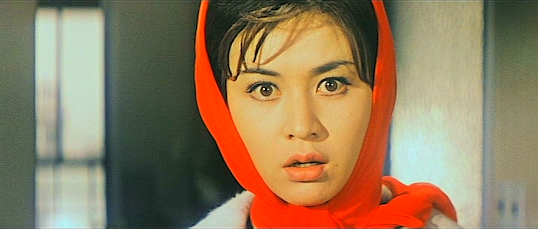 Junko Kano
Junko KanoEpisode 2, ‘Mistress on the Books’, written by Ryozo Kasahara and directedby Kozaburo Yoshimura:
Shinko (Junko Kano) is a soap opera actress dismayed to learn thather character has suddenly been killed off because she’s considered a ‘daikon’(white radish, meaning ‘bad actor’). She complains to the show’s sponsor, whois also the head of a pharmaceutical company and her sugar daddy, but she’sbeen milking him for too much money, so he’s considering cutting her loose andsends one of his minions (Keizo Kawasaki) to deal with the situation…
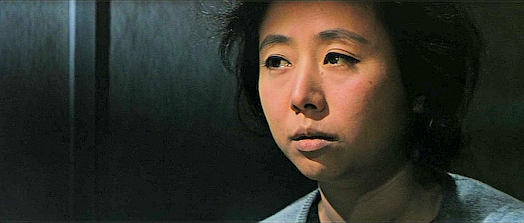 Nobuko Otowa
Nobuko OtowaEpisode 3, ‘Three Women’, written by Kaneto Shindo and directed byTeinosuke Kinugasa
A woman enters an apartment and shoots a man dead. When she isquestioned by a police officer (Ken Utsui), it emerges that the woman, Michiyo(Nobuko Otowa), had left her live-in job at an inn to come and live in theapartment with a salesman, Tashiro (Eiji Funakoshi), and that she had shot himwhen he wanted to break it off. We also learn that Tashiro had a wife (MitsukoMori) who forced him to stop seeing Michiyo. But where did Michiyo get the gun?
 Eiji Funakoshi
Eiji FunakoshiThe English title of this picture seems almost unfair as the menhere do quite a bit of lying themselves! In fact, the unifying theme might moreaccurately be described as infidelity rather than lying, but in any case thetone is one of comic irony with a dash of cynicism. With its moody lighting and cameraangles, Kinugasa’s episode briefly threatens to become more serious, but notfor long.
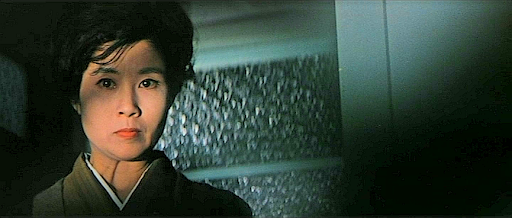 Mitsuko Mori
Mitsuko MoriWhat the picture may lack in depth, it makes up for in entertainmentvalue, and I would certainly recommend it to fans of Daiei movies of this era. Thethree female stars all acquit themselves well, but Junko Kano in particulargets one of her best roles and proves a dab hand at comedy. She never quitereached the heights of Daiei’s top female stars Machiko Kyo, Ayako Wakao andFujiko Yamamoto, perhaps partly because she started later (1957) and retired atthe height of her popularity in 1963 due to an eye issue which was exacerbatedby working under the bright studio lights. At the time of writing, she’s stillalive at 88.
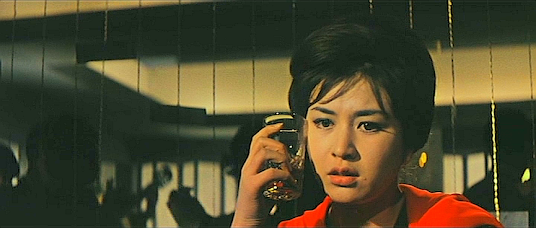
DVD at Amazon Japan (no English subtitles)
January 12, 2025
The Crab Cannery Ship / 蟹工船 / Kanikosen (1953)
Obscure Japanese Film #159
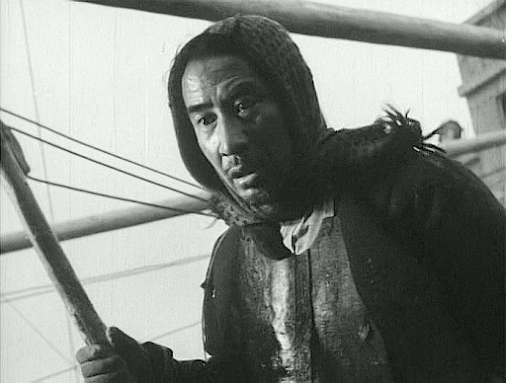 So Yamamura
So YamamuraBased on the 1929 novelof the same name by communist writer Takiji Kobayashi (tortured to death by thepolice in 1933 aged just 30), this independent production depicts the harshconditions on board the titular vessel, where the men are not much better offthan the crabs they’re tasked with catching. The ship itself is closelymodelled on the real-life Hakuai maru,which had started life as a hospital ship before being purchased by a fishingcompany. The crab-catching is carried out using smaller boats, which thenreturn to the ship, where the catch is processed and canned on board. Accordingto Japanese Wikipedia, this put the ship in a legal grey area as the usual navallaws did not apply to a factory ship, and neither did the labour laws thatapplied to factories based on land. Of course, this makes it easy for the ownersto exploit the workers mercilessly and without fear of legal consequences. Manyof those doing the canning are mere children, while the men are worked likeslaves, frequently beaten and occasionally lost overboard with no attempt beingmade to rescue them. This brutal regime is overseen by Asakawa (Ko Mihashi),who even gives orders to the weak and ineffectual ship’s captain (MinosukeYamada), whom he forbids to respond to an SOS call from another ship.
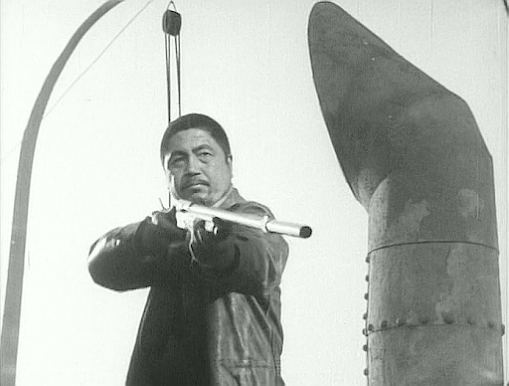 Ko Mihashi
Ko Mihashi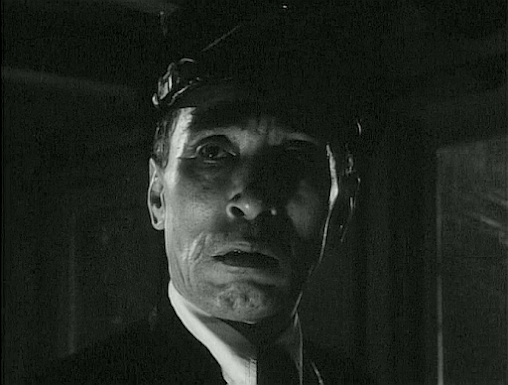 Minosuke Yamada
Minosuke YamadaTheCrab Cannery Ship was the first of six films to bedirected by So Yamamura, an actor perhaps most familiar outside Japan forplaying Admiral Yamamoto in Tora! Tora!Tora! (1970). He gives himself a small part here as a fugitive who hasjoined the crew to escape the police. Yamamura also wrote the screenplay andinvested his own money into the production.
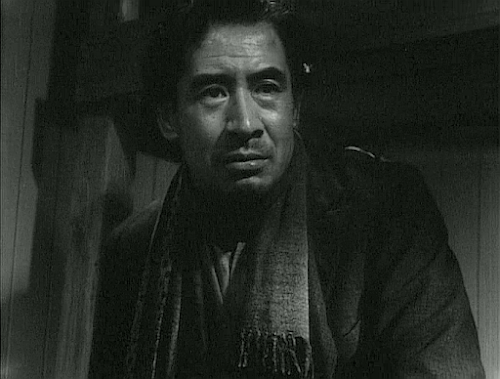 So Yamamura
So YamamuraIt was the second film made byGendai Eigasha, an independent company established in 1951 by former Tohoemployee Tengo Yamada (1916-88) to produce such left-wing, social conscienceworks as this and Tadashi Imai’s Darknessat Noon (1956). Since Yamada’s death, the company has been headed by hiswidow, Hisako Yamada (b.1932), and, although its output has been sporadic,continues to produce films at the time of writing.
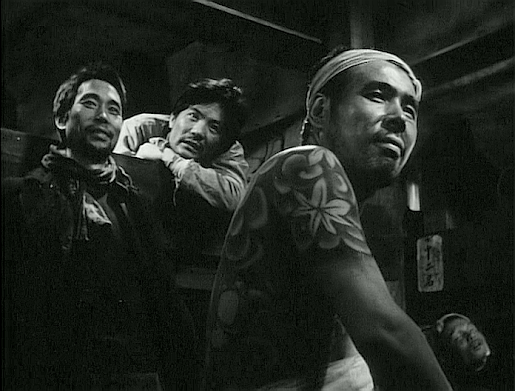 Jun Hamamura (left) and unidentified others
Jun Hamamura (left) and unidentified othersUnsurprisingly for thiskind of story, there are no shades of grey to be found in the characterisations– everyone is either victim or victimiser, and the acting is pretty broadthroughout. There is no star part, and the strengths of the film are in therealism of its setting, its fast pace and its often impressive camerawork.Cinematographer Yoshio Miyajima (who won an award for his work here) crowds thescreen with grim, shadowy faces, lending the picture an almost tangible senseof claustrophobia while tilting the camera horizontally left and rightappropriately (the film is not recommended to anyone prone to seasickness).Meanwhile, Akira Ifukube’s music is so ominous it sounds like he’s warming upfor the following year’s Godzilla.
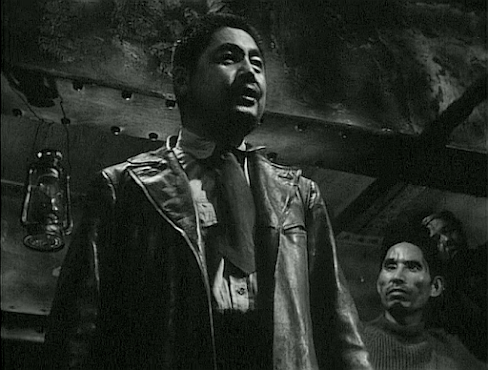 Ko Mihashi and unidentified others
Ko Mihashi and unidentified others Japan’s later economicrecession led to the novel becoming a surprise best-seller again in 2008, and aremake appeared the following year.


